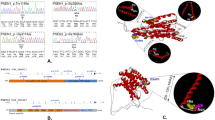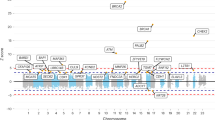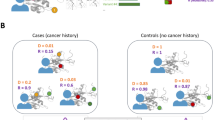Abstract
We identified in breast cancer cases two germline alterations, R62H and R71W, in presenilin-2 (PS-2), a gene involved in familial Alzheimer's disease (FAD). The role of these alleles in FAD is unclear, but neither allele affected Aβ(42)/Aβ(40) ratio. However, both R62H and R71W alterations compromised PS-2 function in Notch signaling in Caenorhabditis elegans and cell growth inhibition in mouse embryonic fibroblasts, and these effects were dependent on gene dosage. We found that both alterations enhanced the degradation of the PS-2 full-length protein, indicating that they may have a loss-of function effect. The effect of the R71W alteration was noticeably stronger, and we observed an almost threefold higher frequency of this allele in breast cancer cases versus controls, but this difference did not reach statistical significance. Nonetheless, these results collectively suggest that the novel PS-2 alleles described here, especially R71W, affect PS-2 function and may potentially confer a moderate risk of susceptibility to breast cancer.
This is a preview of subscription content, access via your institution
Access options
Subscribe to this journal
Receive 50 print issues and online access
$259.00 per year
only $5.18 per issue
Buy this article
- Purchase on Springer Link
- Instant access to full article PDF
Prices may be subject to local taxes which are calculated during checkout





Similar content being viewed by others
References
Alves da Costa C, Paitel E, Mattson MP, Amson R, Telerman A, Ancolio K et al. (2002). Proc Natl Acad Sci USA 99: 4043–4048.
Andrulis IL, Bull SB, Blackstein ME, Sutherland D, Mak C, Sidlofsky S et al. (1998). J Clin Oncol 16: 1340–1349.
Baumeister R, Leimer U, Zweckbronner I, Jakubek C, Grunberg J, Haass C . (1997). Genes Funct 1: 149–159.
Bird TD, Levy-Lahad E, Poorkaj P, Sharma V, Nemens E, Lahad A et al. (1996). Ann Neurol 40: 932–936.
Chen LC, Dollbaum C, Smith HS . (1989). Proc Natl Acad Sci USA 86: 7204–7207.
Citron M, Westaway D, Xia W, Carlson G, Diehl T, Levesque G et al. (1997). Nat Med 3: 67–72.
Cruts M, van Duijn CM, Backhovens H, Van den Broeck M, Wehnert A, Serneels S et al. (1998). Hum Mol Genet 7: 43–51.
De Strooper B, Beullens M, Contreras B, Levesque L, Craessaerts K, Cordell B et al. (1997). J Biol Chem 272: 3590–3598.
Deng G, Pike CJ, Cotman CW . (1996). FEBS Lett 397: 50–54.
Donoviel DB, Hadjantonakis AK, Ikeda M, Zheng H, Hyslop PS, Bernstein A . (1999). Genes Dev 13: 2801–2810.
Gokgoz N, Wunder JS, Mousses S, Eskandarian S, Bell RS, Andrulis IL . (2001). Cancer 92: 2181–2189.
Herreman A, Hartmann D, Annaert W, Saftig P, Craessaerts K, Serneels L et al. (1999). Proc Natl Acad Sci USA 96: 11872–11877.
Hutton M, Hardy J . (1997). Hum Mol Genet 6: 1639–1646.
Jacobsen H, Reinhardt D, Brockhaus M, Bur D, Kocyba C, Kurt H et al. (1999). J Biol Chem 274: 35233–35239.
Janicki SM, Monteiro MJ . (1999). Am J Pathol 155: 135–144.
Janicki SM, Stabler SM, Monteiro MJ . (2000). Neurobiol Aging 21: 829–836.
Jeong SJ, Kim HS, Chang KA, Geum DH, Park CH, Seo JH et al. (2000). FASEB J 14: 2171–2176.
Joutel A, Tournier-Lasserve E . (1998). Semin Cell Dev Biol 9: 619–625.
Kang DE, Soriano S, Xia X, Eberhart CG, De Strooper B, Zheng H et al. (2002). Cell 110: 751–762.
Knight JA, Sutherland HJ, Glendon G, Boyd NF, Andrulis IL . (2002). Ann Epidemiol 12: 27–33.
Levitan D, Greenwald I . (1995). Nature 377: 351–354.
Levitan D, Doyle TG, Brousseau D, Lee MK, Thinakaran G, Slunt HH et al. (1996). Proc Natl Acad Sci USA 93: 14940–14944.
Levy-Lahad E, Wasco W, Poorkaj P, Romano DM, Oshima J, Pettingell WH et al. (1995). Science 269: 973–977.
Li J, Xu M, Zhou H, Ma J, Potter H . (1997). Cell 90: 917–927.
Podlisny MB, Citron M, Amarante P, Sherrington R, Xia W, Zhang J et al. (1997). Neurobiol Dis 3: 325–337.
Ponder BA . (2001). Nature 411: 336–341.
Rogaev EI, Sherrington R, Rogaeva EA, Levesque G, Ikeda M, Liang Y et al. (1995). Nature 376: 775–778.
Saura CA, Tomita T, Davenport F, Harris CL, Iwatsubo T, Thinakaran G . (1999). J Biol Chem 274: 13818–13823.
Scheuner D, Eckman C, Jensen M, Song X, Citron M, Suzuki N et al. (1996). Nat Med 2: 864–870.
Sherrington R, Froelich S, Sorbi S, Campion D, Chi H, Rogaeva EA et al. (1996). Hum Mol Genet 5: 985–988.
Sherrington R, Rogaev EI, Liang Y, Rogaeva EA, Levesque G, Ikeda M et al. (1995). Nature 375: 754–760.
Soriano S, Kang DE, Fu M, Pestell R, Chevallier N, Zheng H et al. (2001). J Cell Biol 152: 785–794.
Steiner H, Capell A, Pesold B, Citron M, Kloetzel PM, Selkoe DJ et al. (1998). J Biol Chem 273: 32322–32331.
Struhl G, Greenwald I . (1999). Nature 398: 522–525.
Takano T, Sahara N, Yamanouchi Y, Mori H . (1997). Neurosci Lett 221: 205–207.
Thinakaran G, Borchelt DR, Lee MK, Slunt HH, Spitzer L, Kim G et al. (1996). Neuron 17: 181–190.
Thinakaran G, Harris CL, Ratovitski T, Davenport F, Slunt HH, Price DL et al. (1997). J Biol Chem 272: 28415–28422.
Walker ES, Martinez M, Brunkan L, Goate A . (2005). J Neurochem 92: 294–301.
Wolozin B, Iwasaki K, Vito P, Ganjei JK, Lacana E, Sunderland T et al. (1996). Science 274: 1710–1713.
Xia X, Qian S, Soriano S, Wu Y, Fletcher AM, Wang XJ et al. (2001). Proc Natl Acad Sci USA 98: 10863–10868.
Ye Y, Lukinova N, Fortini ME . (1999). Nature 398: 525–529.
Yu G, Chen F, Levesque G, Nishimura M, Zhang DM, Levesque L et al. (1998). J Biol Chem 273: 16470–16475.
Yu G, Chen F, Nishimura M, Steiner H, Tandon A, Kawarai T et al. (2000). J Biol Chem 275: 27348–27353.
Acknowledgements
PS-2 antibodies were generous gifts of Drs P Mathews, G Thinakaran, P Davies and P Fraser. We are grateful to S Bull, R Parkes and Dushanthi Pinnaduwage for assistance with statistical analyses, and P Ray for DNA specimens. This work was funded by the USAMRMC with fellowship to MDT, the Canadian Breast Cancer Research Initiative (ILA, JK), the National Cancer Institute of Canada with funds provided by the Terry Fox Run (ILA) and NCI/NIH (U01 CA69467 (ILA)).
Author information
Authors and Affiliations
Corresponding author
Rights and permissions
About this article
Cite this article
To, M., Gokgoz, N., Doyle, T. et al. Functional characterization of novel presenilin-2 variants identified in human breast cancers. Oncogene 25, 3557–3564 (2006). https://doi.org/10.1038/sj.onc.1209397
Received:
Revised:
Accepted:
Published:
Issue Date:
DOI: https://doi.org/10.1038/sj.onc.1209397
Keywords
This article is cited by
-
Singular cases of Alzheimer’s disease disclose new and old genetic “acquaintances”
Neurological Sciences (2021)
-
Exploring the Role of PSEN Mutations in the Pathogenesis of Alzheimer’s Disease
Neurotoxicity Research (2020)
-
In silico modeling of pathogenic or possibly pathogenic point mutations in PSEN2
Molecular & Cellular Toxicology (2016)
-
Loss of presenilin 2 is associated with increased iPLA2 activity and lung tumor development
Oncogene (2014)
-
Presenilin-2 gene mutation presenting as Lewy Body dementia?
Neurological Sciences (2011)



